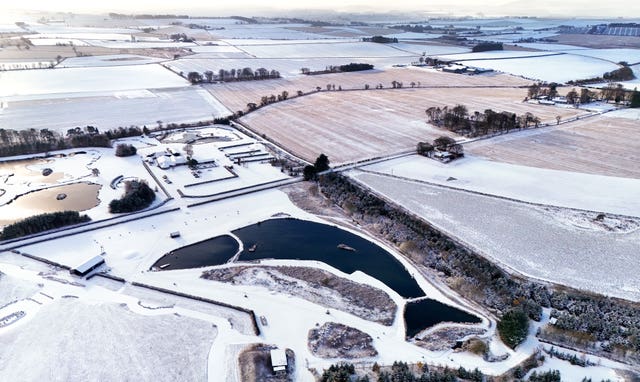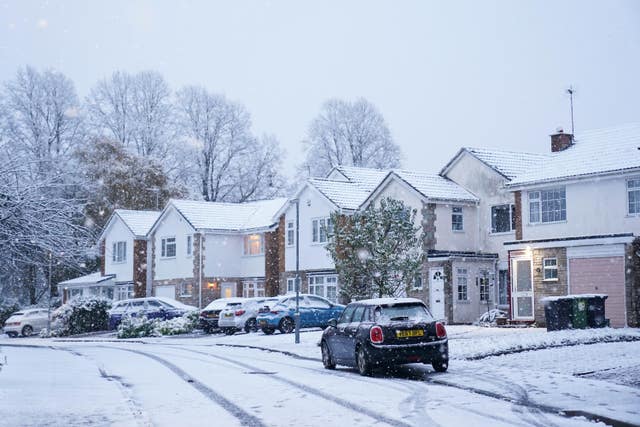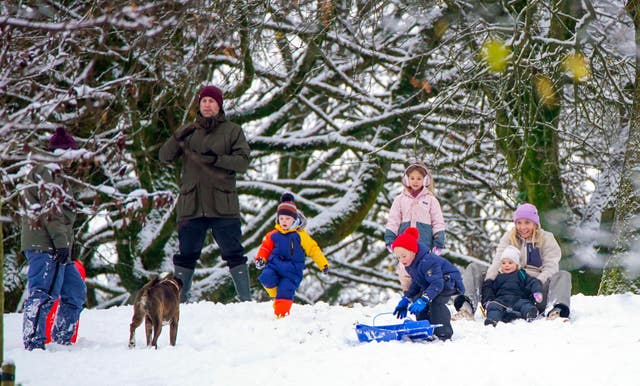A new ice warning has been issued after snowy conditions forced the closure of more than 200 schools and led to widespread travel disruption.
The Met Office has put in place a yellow warning for ice for much of southern England, the Midlands and eastern Wales from 5pm on Tuesday to 10am on Wednesday.
Several other warnings for snow and ice are in force across the UK, with the Met Office advising that vehicles could be stranded, power cuts may occur and rural areas could be cut off.
Snowfall was also widely reported, with 12cm of lying snow recorded at Watnall, Nottinghamshire on Tuesday morning as an Arctic airmass influenced the UK’s weather.
Thousands of train passengers suffered disruption due to the weather on Tuesday morning.
By 11am on Tuesday, some 64 out of a total of 120 services planned by East Midlands Railway were cancelled or delayed by at least half an hour, according to the trains.im punctuality and reliability website.
Monday night saw sub-zero temperatures for much of the UK, reaching as low as -11.2C at Braemar in Aberdeenshire.
Met Office spokesman Stephen Dixon said temperatures could drop to -12C in rural parts of Scotland and -7C in rural parts of Wales on Wednesday night.

“So it’ll feel like that first taste of winter for many with that snow and ice risk layered on top.”
He added: “The highest accumulations are likely over the mountains in Scotland, where over higher ground you could see around 20cm of snow through this week accumulating on the ground.
“They are not necessarily the most disruptive snowfalls, but it only takes a couple of centimetres on lower ground to cause some level of travel disruption.”
A Stagecoach bus in Aberdeenshire toppled onto its side with a passenger on board in icy conditions on Tuesday morning in the New Leeds area.
A spokesperson for Stagecoach North Scotland said: “We can confirm that one of our vehicles operating on service X67 has been involved in an incident at New Leeds this morning due to ice on the road.
“One passenger was on board, and there were no injuries.”

The amber warning covers the east and north of England, the Midlands, and Yorkshire and the Humber, with yellow alerts coming into place for the South East, South West and London until 6pm on Saturday.
Met Office Chief Meteorologist Neil Armstrong said: “With cold Arctic air firmly in place over the UK, continued winter hazards are likely through much of this week, with further updates to warnings likely in the coming days.”
The Met Office has issued a yellow warning for snow and ice along the east coast of Scotland and England from Berwickshire to Suffolk from 6pm on Tuesday to midday on Wednesday.
A yellow warning for snow and ice has also been issued for Northern Ireland from 6pm on Tuesday to 10am on Wednesday, with a separate warning also in place across most of Wales and parts of the West Midlands until 10am on Wednesday.
There are also snow and ice warnings in place covering the north of Scotland until 10am on Wednesday and parts of western Scotland from 7pm on Tuesday to 10am on Wednesday.

It added that temperatures were likely to increase from the south-west this weekend, though this will be accompanied by some strong winds and heavy rain.
The Alzheimer’s Society warned that cold weather can be “particularly challenging” for people with dementia.
“Colder temperatures can be difficult for a person with dementia to adjust to, and they may not always be able to communicate that they are cold – or they may not even recognise it themselves,” the charity said.
Another charity, Asthma + Lung UK, urged those with lung conditions to be “extra careful”.
The charity warned cold weather can trigger potentially life-threatening asthma attacks or “flare-ups” for people with other lung conditions.






